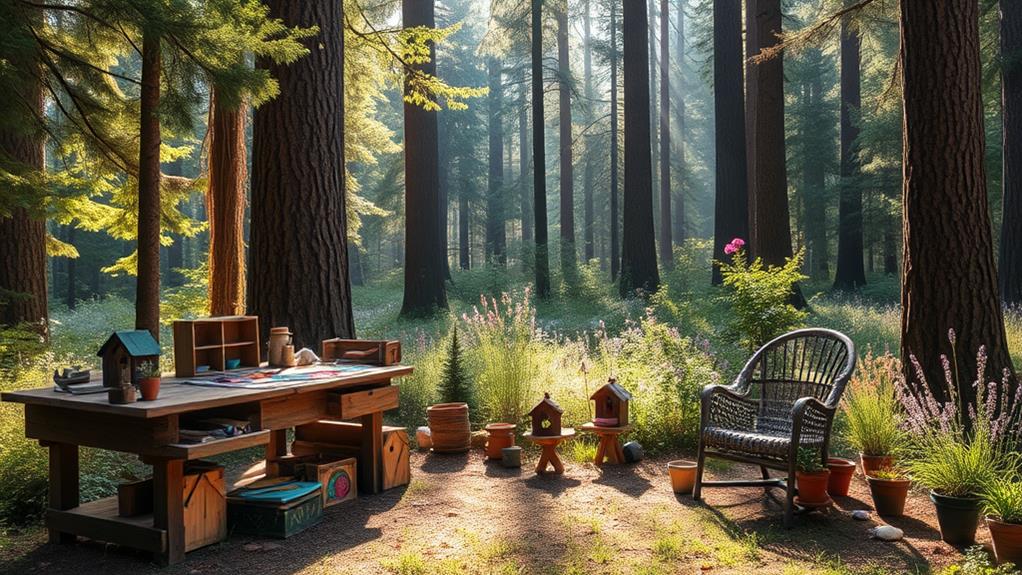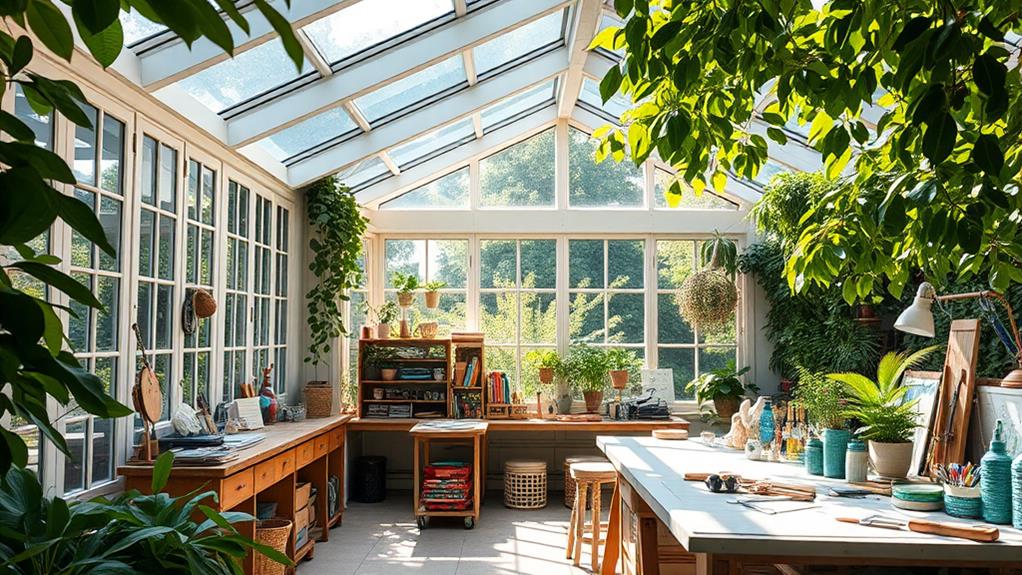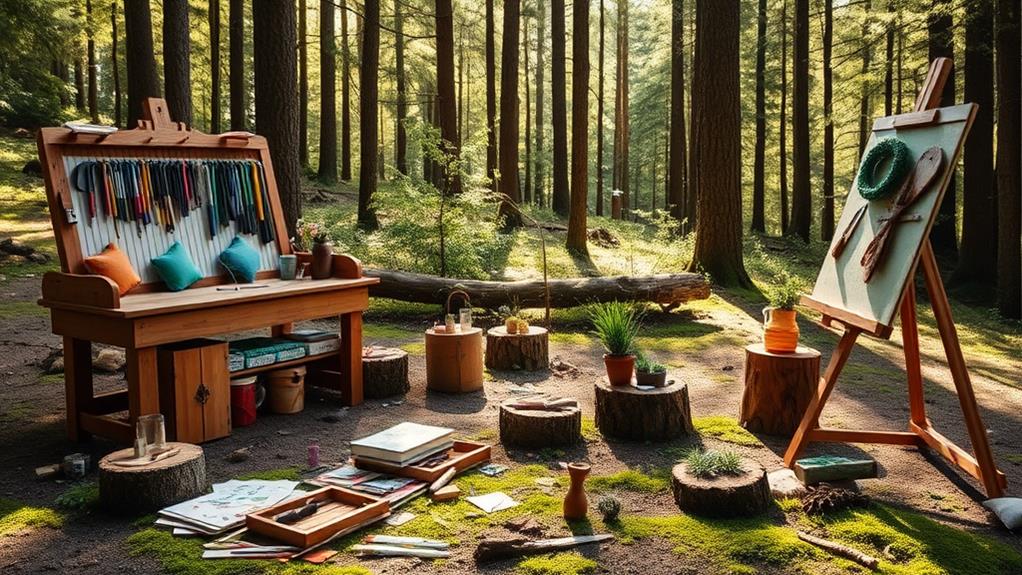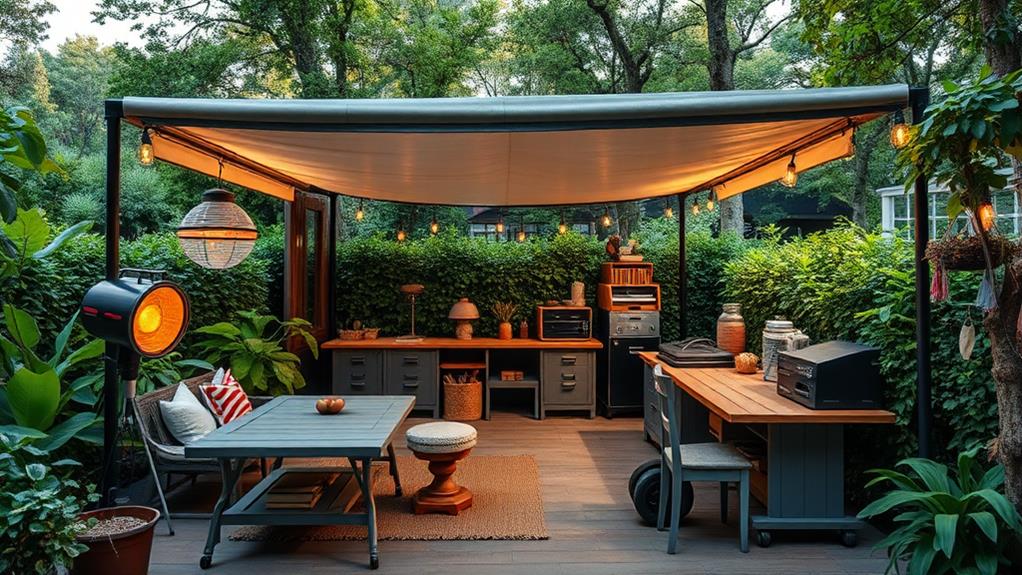Creating an outdoor crafting space in nature combines DIY ingenuity with the tranquility of the outdoors. Key considerations include choosing a location with ample natural light and protection from the elements, implementing weather-resistant design features, and maximizing storage solutions for supplies. Comfortable seating and workstations are essential for prolonged crafting sessions, while incorporating natural elements can enhance inspiration. Careful planning ensures year-round usability and allows for personalization of the space. By thoughtfully renovating an outdoor area for crafting, you can create a unique haven that nurtures creativity and productivity. The following insights will guide you in crafting your perfect outdoor workspace.
Choosing the Perfect Location

When selecting the ideal spot for your outdoor crafting area, consider factors such as natural light, protection from the elements, and proximity to your home. A location with ample sunlight throughout the day will provide optimal working conditions and enhance visibility for detailed projects. However, ensure there's enough shade to prevent overexposure and protect sensitive materials.
Look for areas that offer natural windbreaks, such as walls, fences, or dense vegetation, to shield your workspace from strong gusts. Consider the terrain and drainage to avoid water accumulation during rainy periods. Proximity to your home is crucial for convenience and access to utilities like electricity and water.
Assess the available space and envision how it can accommodate your crafting needs. Factor in storage requirements for tools and materials, as well as room for work surfaces and seating. Consider the noise level of your activities and choose a location that won't disturb neighbors or family members.
Lastly, evaluate the surrounding landscape and views. A picturesque setting can inspire creativity and make your outdoor crafting experience more enjoyable. Balance functionality with aesthetics to create a harmonious and productive space.
Weather-Resistant Design Essentials
With the perfect location selected, the next step is to ensure your outdoor crafting area can withstand various weather conditions. Key weather-resistant design essentials include a sturdy, waterproof roof or awning to protect against rain and direct sunlight. Consider using materials like polycarbonate sheets or treated wood for longevity and durability.
Incorporate proper drainage systems to prevent water accumulation and potential damage to your crafting supplies and equipment. Install gutters and downspouts to direct water away from the area, and ensure the ground is slightly sloped for natural runoff.
Choose weather-resistant furniture and storage solutions, such as powder-coated metal or treated wood pieces. Opt for waterproof storage containers to keep supplies dry and protected from humidity. Install weatherproof electrical outlets and lighting fixtures to ensure safety and functionality in all conditions.
Consider adding windbreaks or protective screens to shield your crafting area from strong gusts and debris. Use weather-resistant fabrics for any curtains or cushions, and select outdoor-rated paint or sealants for all exposed surfaces. By incorporating these weather-resistant design elements, you'll create a durable and enjoyable outdoor crafting space that can be used year-round.
Maximizing Natural Light

Natural light's importance in an outdoor crafting space cannot be overstated. It enhances visibility, color accuracy, and overall crafting experience.
To maximize natural light, consider the orientation of your space. South-facing areas typically receive the most consistent sunlight throughout the day, making them ideal for crafting activities.
Incorporate large windows or glass doors to allow ample light penetration. Skylights can be an excellent addition, especially for covered spaces, bringing in overhead illumination. Use reflective surfaces strategically to bounce light around the area. Light-colored walls, ceilings, and floors can significantly brighten the space.
Consider installing adjustable shading options like retractable awnings or pergolas with movable slats. These allow you to control light intensity and prevent glare on sunny days. For areas with limited natural light, supplement with full-spectrum artificial lighting that mimics daylight.
Prune nearby trees or shrubs that may cast unwanted shadows on your crafting area. Position your work surfaces to take full advantage of the available light, placing them near windows or in open areas. By maximizing natural light, you create an inviting and functional outdoor crafting space that enhances creativity and productivity.
Storage Solutions for Outdoor Supplies
Effective storage solutions are fundamental to maintaining an organized and functional outdoor crafting space. When designing storage for outdoor supplies, consider weatherproof options that protect materials from the elements. Plastic storage containers with tight-fitting lids are ideal for keeping items dry and safe from pests.
Install wall-mounted shelving units or pegboards to maximize vertical space and keep tools easily accessible.
For larger equipment, consider a garden shed or storage cabinet specifically designed for outdoor use. These structures can be customized with built-in workbenches and shelving to accommodate various crafting needs. Utilize clear, labeled containers to sort and store smaller items like beads, paint supplies, or fabric scraps. This approach ensures quick identification and retrieval of materials.
Incorporate mobile storage solutions, such as rolling carts or tool caddies, to easily transport supplies between indoor and outdoor workspaces. For frequently used items, consider open shelving or hanging baskets for quick access. Lastly, invest in storage furniture that serves dual purposes, such as benches with hidden compartments or tables with built-in drawers, to maximize space efficiency in your outdoor crafting area.
Comfortable Seating and Workstations

Comfortable seating and well-designed workstations are essential components of any outdoor crafting area. When renovating for outdoor crafting, prioritize ergonomic seating options that can withstand various weather conditions.
Consider weatherproof chairs with adjustable heights and supportive backrests to accommodate different crafting activities and body types. Incorporate cushions made from quick-drying, UV-resistant fabrics for added comfort and longevity.
For workstations, opt for sturdy tables with ample surface area and storage capabilities. Weather-resistant materials like treated wood, metal, or high-density polyethylene are ideal choices.
Include features such as built-in measuring grids, tool organizers, and extendable leaves to maximize functionality. Consider installing adjustable overhead lighting or incorporating portable task lights to ensure proper illumination for detailed work.
To enhance the crafting experience, integrate multi-functional furniture pieces like storage benches or folding tables that can be easily stowed away when not in use. Create designated zones for different crafting activities by arranging workstations and seating areas strategically.
This organization promotes efficiency and allows for simultaneous projects. By focusing on comfort and practicality in your outdoor crafting space, you'll create an inviting environment that fosters creativity and productivity.
Incorporating Inspiring Natural Elements
Infusing your outdoor crafting space with natural elements can significantly enhance creativity and inspiration. Consider incorporating living plants, such as potted herbs, flowering shrubs, or vertical gardens, to add color and texture to your workspace. These not only provide visual interest but can also serve as materials for pressed flower art or botanical crafts.
Integrate natural materials like wood, stone, and bamboo into your crafting area. A reclaimed wood table or shelving unit can add rustic charm, while smooth river rocks can serve as paperweights or painting surfaces. Hang wind chimes or install a small water feature to introduce soothing natural sounds that promote relaxation and focus.
Maximize natural light by positioning your workspace to take advantage of the sun's path throughout the day. Use reflective surfaces or strategically placed mirrors to amplify available light. For shade, consider pergolas draped with climbing vines or retractable awnings that allow you to control light exposure. By thoughtfully incorporating these natural elements, you can create an outdoor crafting space that not only functions well but also nurtures your creative spirit through a connection with nature.
Year-Round Usability Considerations

Versatility is key when designing an outdoor crafting space for year-round use. To ensure functionality across seasons, consider implementing retractable awnings or pergolas with adjustable covers to protect against sun, rain, and snow. Install proper lighting for darker months, including task lighting for workspaces and ambient lighting for overall illumination.
Temperature control is crucial for comfort. Incorporate outdoor heaters for colder days and strategically placed fans or misting systems for warmer periods. Choose weather-resistant furniture and storage solutions to withstand varying conditions. Opt for materials like treated wood, metal, or high-quality plastics that can endure exposure to the elements.
Flooring should be slip-resistant and easy to clean, such as composite decking or sealed concrete. Consider installing windbreaks or privacy screens to shield the area from strong gusts and create a more controlled environment. Ensure proper drainage to prevent water accumulation during wet seasons.
Lastly, invest in multi-functional equipment and storage options that can adapt to different projects and weather conditions. By addressing these year-round usability considerations, your outdoor crafting space will remain a productive and enjoyable area regardless of the season.
Personalizing Your Outdoor Craft Space
Your outdoor craft space should reflect your unique style and creative spirit. Start by selecting a color scheme that inspires you and complements the natural surroundings. Consider painting furniture, storage units, or even the floor to achieve a cohesive look. Incorporate personal touches like handmade decorations, inspirational quotes, or artwork to make the space truly your own.
Customize your workstation to suit your specific crafting needs. Install modular shelving or pegboards for flexible storage options, and add task lighting to ensure optimal visibility for detailed work. Choose comfortable seating that supports long crafting sessions, such as ergonomic chairs or cushioned benches.
Create designated areas for different activities within your space. Set up a cozy reading nook for brainstorming or a display area to showcase finished projects. Integrate elements of nature by adding potted plants, hanging baskets, or a small herb garden to enhance the outdoor ambiance.
Frequently Asked Questions
How Much Does It Typically Cost to Build an Outdoor Crafting Space?
The cost of building an outdoor crafting space typically ranges from $1,000 to $10,000, depending on factors such as size, materials, and amenities. Basic setups may include a work table, storage, and shade, while elaborate spaces might feature electricity and plumbing.
Are There Zoning Laws or Permits Required for Outdoor Craft Spaces?
Picture a serene outdoor workspace—but before you build, consider local regulations. Zoning laws and permits are often required for outdoor structures, varying by location and project scope. Consult your local planning department for specific requirements and guidelines.
How Can I Protect My Crafting Materials From Pests and Wildlife?
To protect crafting materials from pests and wildlife, use airtight, weatherproof storage containers. Implement proper sealing techniques, elevate storage units, and employ natural repellents. Regularly inspect and clean the area to deter unwanted visitors and maintain material integrity.
What Safety Measures Should I Implement in an Outdoor Crafting Area?
Ah, safety in outdoor crafting—because nothing screams "relaxation" like potential hazards! Seriously though, implement proper lighting, use non-slip surfaces, store sharp tools securely, have a first-aid kit handy, and ensure adequate ventilation for any chemical-based crafts.
Can I Use Solar Power to Run Electrical Equipment in My Craft Space?
Yes, solar power can be utilized to run electrical equipment in your craft space. Installing solar panels and a battery storage system can provide a sustainable energy source for tools, lighting, and other electrical devices in your outdoor workspace.
Conclusion
As the final brushstroke completes this canvas of outdoor creativity, the fusion of nature and artistry blooms into a sanctuary of inspiration. Like a well-tended garden, a thoughtfully designed outdoor craft space nurtures the seeds of imagination, allowing them to flourish in all seasons. By harmonizing practical considerations with the raw beauty of the natural world, these open-air studios become fertile ground for artistic expression, inviting makers to weave their creations into the very fabric of the landscape.

